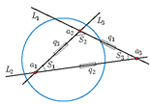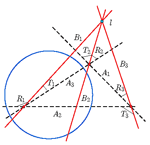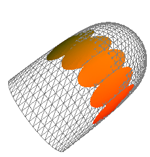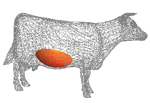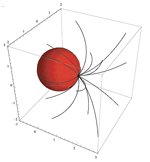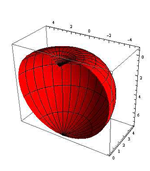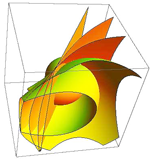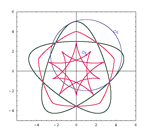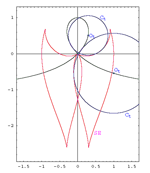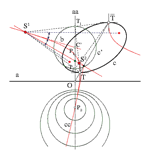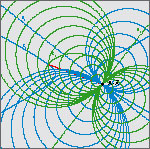 |
Znanstveno-stručni
časopis Hrvatskog društva za geometriju i grafiku Scientific and Professional Journal |
|
| Norman John Wildberger (n.wildberger@unsw.edu.au)
Universal Hyperbolic Geometry II: A pictorial overviewThis article provides a simple pictorial introduction to universal hyperbolic geometry. We explain how to understand the subject using only elementary projective geometry, augmented by a distinguished circle. This provides a completely algebraic framework for hyperbolic geometry, valid over the rational numbers (and indeed any field not of characteristic two), and gives us many new and beautiful theorems. These results are accurately illustrated with colour diagrams, and the reader is invited to check them with ruler constructions and measurements.Key words: hyperbolic geometry, projective geometry, rational trigonometry, quadrance, spread, quadrea  Article in PDF. Article in PDF. |
| Ana Sliepčević, Ema Jurkin (ejurkin@rgn.hr, anas@grad.hr)
Snails in Hyperbolic PlaneThe properties of the limacon of Pascal in the Euclidean plane are well known. The aim of this paper is to obtain the curves in the hyperbolic plane having the similar properties. That curves are named hyperbolic snails and defined as the circle pedal curves.It is shown that all of them are circular quartics, while some of them are entirely circular. Key words: limacon of Pascal, hyperbolic plane, entirely circular 4-order curves  Article in PDF. Article in PDF. |
|
| Márta Szilvási-Nagy (szilvasi@math.bme.hu)
Surface Patches Constructed from Curvature DataIn this paper a technique for the construction of smooth surface patches fitted on triangle meshes is presented. Such a surface patch may replace a well defined region of the mesh, and can be used e.g. in retriangulation, mesh-simplification and rendering.
|
|
| János Pallagi, Benedek Schultz, Jenö Szirmai (jpallagi@math.bme.hu, schultz.benedek@gmail.com, szirmai@math.bme.hu)
Visualization of Geodesic Curves, Spheres and Equidistant Surfaces in S^2×R Space The S2×R geometry is derived by direct product of the
spherical plane S2 and the real line R. In [9] the third author has etermined the geodesic curves, geodesic balls of S2×R space, computed their volume and defined the notion of the geodesic ball packing and its density. Moreover, he has developed a procedure to determine the density of the geodesic ball packing for generalized Coxeter space groups of S2×R and applied this algorithm to them. |
|
| Tibor Dósa (dosa.tibor@t-online.de)
Equidistant-, Own-Equidistant- and Self-Equidistant-Curves in the Euclidean PlaneThere are given two curves in the plane. We are looking for the equidistant-curve of both in the following sense: what is the geometric locus of the centers of the circles that are tangent to both given curves? These points are in the same distance from the two given curves. The own-equidistant curve of a given curve is the locus of the centers of the circles that are twice tangent to the curve. |
|
| Sonja Gorjanc, Tibor Schwarcz, Miklós Hoffman (sgorjanc@grad.hr, schwartz@inf.unideb.hu, hofi@ektf.hu)
On Central Collineations which Transform a Given Conic to a CircleIn this paper we prove that for a given axis the centers of all central collineations which transform a given proper conic c into a circle, lie on one conic cc confocal to the original one. The conics c and cc intersect into real points and their common diametral chord is conjugate to the direction of the given axis.Furthermore, for a given center S the axes of all central collineations that transform conic c into a circle form two pencils of parallel lines. The directions of these pencils are conjugate to two common diametral chords of c and the confocal conic through S that cuts c at real points. Finally, we formulate a theorem about the connection of the pair of confocal conics and the fundamental elements of central collineations that transform these conics into circles. Key words: central collineation, confocal conic,; Apollonian circles  Article in PDF. Article in PDF. |
